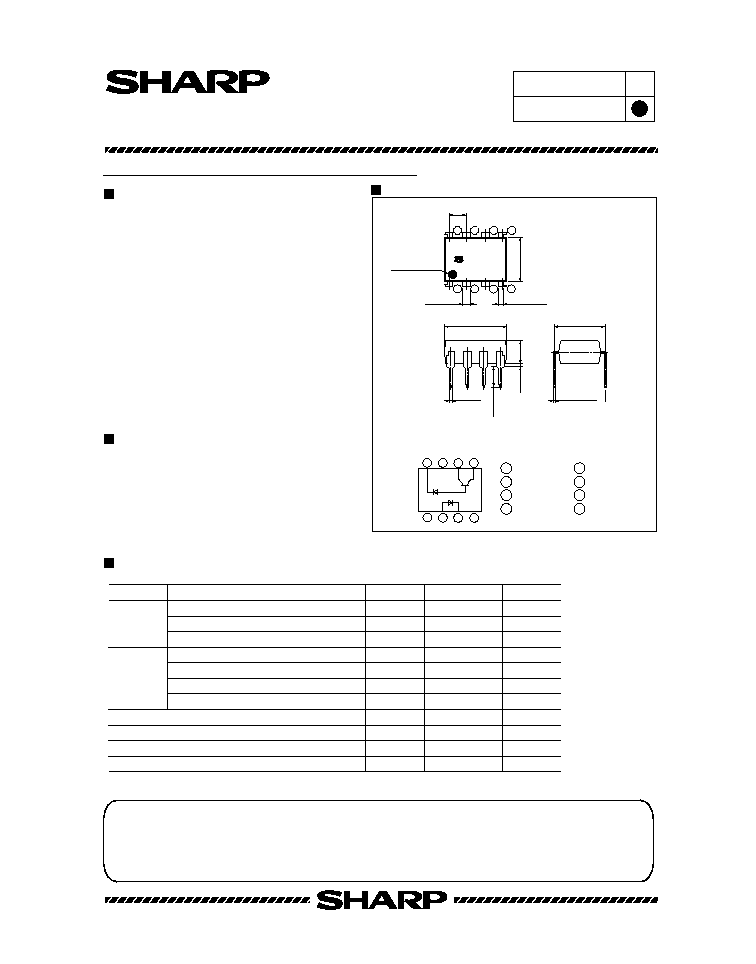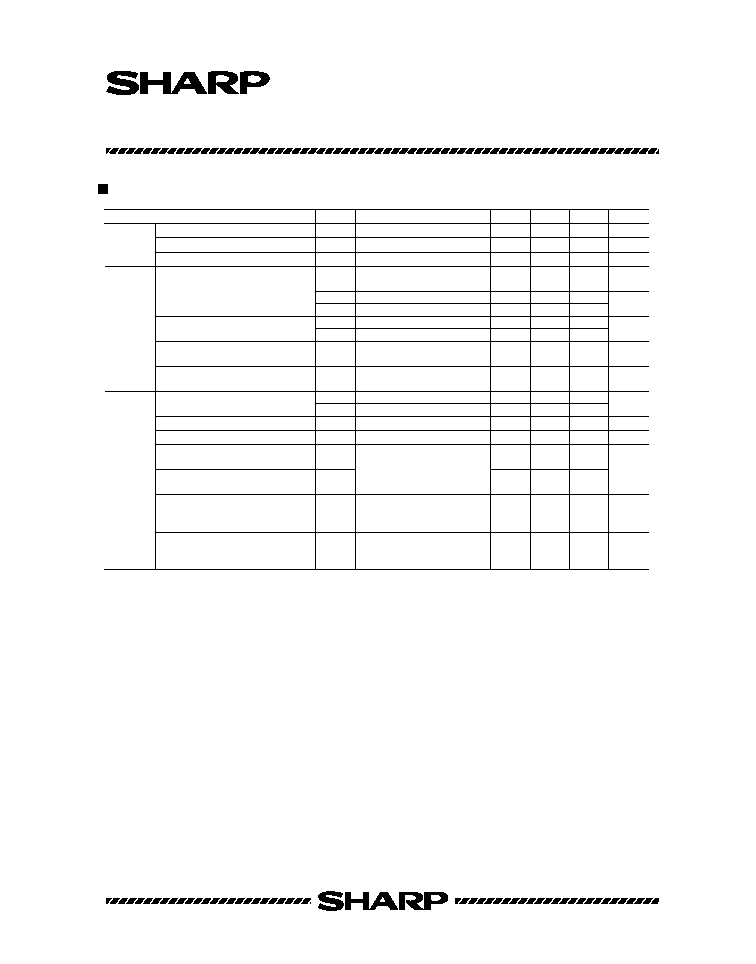
(Notice)
∑In the absence of confirmation by device specification sheets, SHARP takes no responsibility for any defects that may occur in equipment
using any SHARP devices shown in catalogs, data books, etc. Contact SHARP in order to obtain the latest device specification sheets before
using any SHARP device.
∑Specifications are subject to change without notice for improvement.
(Internet)
∑Data for Sharp's optoelectronic/power devices is provided on internet. (Address http://sharp-world.com/ecg/)
(Unit: mm)
Outline Dimensions
Features
Applications
Absolute Maximum Ratings
(1) Programmable controller
(2) Inverter
Internal connection
4
1
3
2
Cathode
NC
NC
Anode
8
5
7
6
NC
Vcc
GND
Vo
1
2
3
4
5
6
7
8
Anode mark
( Ta=25∞C)
Rating
Input
Forward current
I
F
25
mA
Reverse voltage
V
R
5
V
Power dissipation
P
45
mW
Output
Supply voltage
V
CC
-
0.5 to +30
V
Output voltage
V
O
-
0.5 to +20
V
Output current
I
O
8
mA
Power dissipation
P
O
100
mW
Isolation voltage
V
iso
5.0
kV
(rms)
Operating temperature
T
opr
-
55 to +100
∞C
Storage temperature
T
stg
-
55 to +125
∞C
Soldering temperature
T
sol
270
∞C
*1
*2
Parameter
Symbol
Unit
2D-010305
Under development
New product
PC957L0NSZ
Photocoupler
1 / 2
(1) High instantaneous common mode rejection
voltage (CMR:MIN. 15kV/
µ
s)
(2) High speed response
(t
PHL
:MAX. 0.8
µ
s , t
PLH
:MAX. 0.8
µ
s)
(3) Isolation voltage(Viso(rms) : 5.0kV)
(4) 8-pin DIP package
(5) Flow soldering : 280∞C for 6s or less
(6) Recognized by UL (file No. E64380)
Under preparation for VDE standard
*1 40 to 60% RH, for 1 minute
*2 For 10s at the portion of 0.2mm or more from the root of lead pins
High Speed and High CMR
*
OPIC Photocoupler
* "OPIC" (Optical IC) is a trademark of the SHARP Corporation. An OPIC consists of
a light-detecting element and signal-processing circuit integrated onto a single chip.
1
2
3
4
5
6
7
8
PC957L
6.5
±
0.5
2.54
±
0.25
1.2
±
0.3
0.85
±
0.2
9.66
±
0.5
7.62
±
0.3
0.26
±
0.1
0.5
TYP.
3.5
±
0.5
3.4
±
0.5
0.5
±
0.1

Electro-optical Characteristics
2D-010305
PC957L0NSZ
Photocoupler
As of April 2001
2 / 2
MIN.
TYP.
MAX.
Input
V
F
1.7
1.95
V
Reverse current
I
R
10
µ
A
µ
A
µ
A
µ
A
Terminal capacitance
C
t
60
250
pF
Output
-
3
500
nA
I
OH(1)
I
OH(2)
-
0.01
1.0
I
OH(3)
I
F
=0, V
CC
=15V, V
O
=15V *3
I
F
=0, V
CC
=15V, V
O
=15V
-
-
50
I
CCH(1)
-
0.02
1.0
I
CCH(2)
-
-
2.0
Low level supply current
I
CCL
-
120
-
Low level output voltage
V
OL
-
0.1
0.4
V
Transfer
characteristics
Current transfer ratio
CTR(1)
CTR(2)
19
-
15
-
50
%
5
◊
10
10
10
11
-
Isolation resistance
R
ISO
Floating capacitance
C
f
-
0.6
1.0
pF
V=0V, f=1MHz
t
PHL
-
0.8
0.2
0.6
0.8
µ
s
µ
s
µ
s
F
t
PLH
-
Instantaneous common mode rejection
voltage "Output: High level"
CM
H
15
-
kV/
Instantaneous common mode rejection
voltage "Output: Low level"
CM
L
-
15
30
-
30
-
kV/
DC500V, 40 to 60%RH
I
F
=16mA, V
CC
=15V,
V
O
=OPEN
=OPEN *3
I
F
=16mA, V
CC
=4.5V,
I
O
=2.4mA
High level output current
High level supply current
I
F
=16mA
V
R
=5V
V
F
=0, f=1MHz
I
F
=0, V
CC
=5.5V
V
O
=5.5V
I
F
=0, V
CC
=15V, V
O
=OPEN
I
F
=0, V
CC
=15V, V
O
I
F
=16mA, V
CC
=5V
R
L
=1.9k
I
F
=0mA, R
L
=1.9k
,
V
CM
=1.0kV
P-P
,
V
CC
=5V
V
CM
=1.0kV
P-P
,
V
CC
=5V
Forward voltage
I
F
=16mA, R
L
=1.9k
,
-
-
-
-
Parameter
Symbol
Conditions
Unit
"High
Low" transfer time
"Low
High" transfer time
*3 Ta=0 to 70∞C
I
F
=16mA, V
CC
=4.5V, V
O
=0.4V
I
F
=16mA, V
CC
=4.5V, V
O
=0.4V *3
(Ta=25∞C)

NOTICE
q
The circuit application examples in this publication are provided to explain representative applications of SHARP
devices and are not intended to guarantee any circuit design or license any intellectual property rights. SHARP takes
no responsibility for any problems related to any intellectual property right of a third party resulting from the use of
SHARP's devices.
q
Contact SHARP in order to obtain the latest device specification sheets before using any SHARP device. SHARP
reserves the right to make changes in the specifications, characteristics, data, materials, structure, and other contents
described herein at any time without notice in order to improve design or reliability. Manufacturing locations are
also subject to change without notice.
q
Observe the following points when using any devices in this publication. SHARP takes no responsibility for damage
caused by improper use of the devices which does not meet the conditions and absolute maximum ratings to be used
specified in the relevant specification sheet nor meet the following conditions:
(i) The devices in this publication are designed for use in general electronic equipment designs such as:
- - - Personal computers
- - - Office automation equipment
- - - Telecommunication equipment [terminal]
- - - Test and measurement equipment
- - - Industrial control
- - - Audio visual equipment
- - - Consumer electronics
(ii) Measures such as fail-safe function and redundant design should be taken to ensure reliability and safety when
SHARP devices are used for or in connection with equipment that requires higher reliability such as:
- - - Transportation control and safety equipment (i.e., aircraft, trains, automobiles, etc.)
- - - Traffic signals
- - - Gas leakage sensor breakers
- - - Alarm equipment
- - - Various safety devices, etc.
(iii)SHARP devices shall not be used for or in connection with equipment that requires an extremely high level of
reliability and safety such as:
- - - Space applications
- - - Telecommunication equipment [trunk lines]
- - - Nuclear power control equipment
- - - Medical and other life support equipment (e.g., scuba).
q
Contact a SHARP representative in advance when intending to use SHARP devices for any "specific" applications
other than those recommended by SHARP or when it is unclear which category mentioned above controls the
intended use.
q
If the SHARP devices listed in this publication fall within the scope of strategic products described in the Foreign
Exchange and Foreign Trade Control Law of Japan, it is necessary to obtain approval to export such SHARP devices.
q
This publication is the proprietary product of SHARP and is copyrighted, with all rights reserved. Under the copyright
laws, no part of this publication may be reproduced or transmitted in any form or by any means, electronic or
mechanical, for any purpose, in whole or in part, without the express written permission of SHARP. Express written
permission is also required before any use of this publication may be made by a third party.
q
Contact and consult with a SHARP representative if there are any questions about the contents of this publication.


